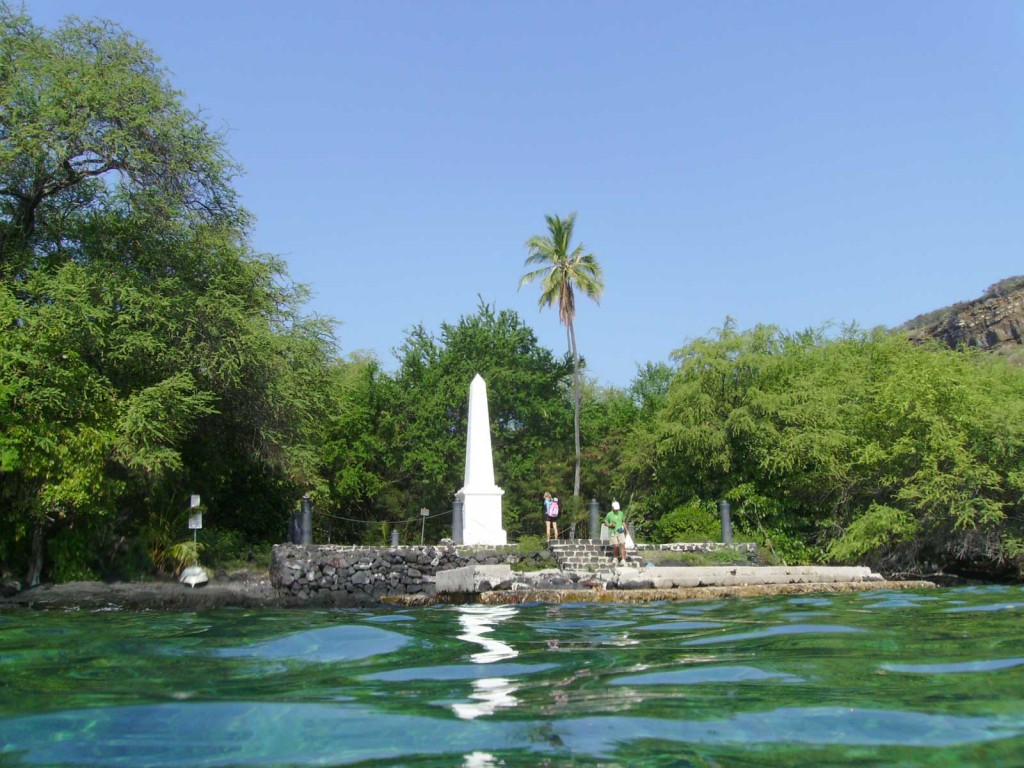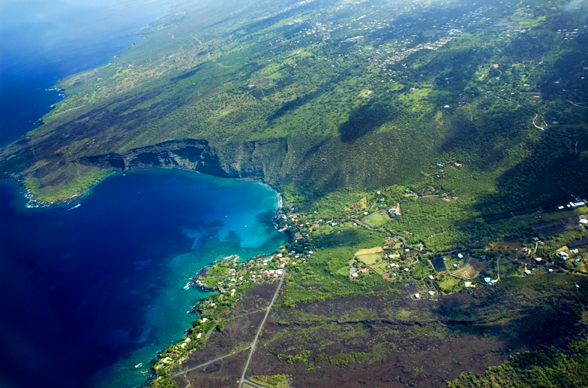Kealakekua Bay & Captain Cook Monument in Kailua-Kona Hawaii - Not-Quite-the-World-Traveler Review View across the bay to the Captain Cook Monument
View across the bay to the Captain Cook Monument
Sparkling
turquoise blue water, a veritable rainbow of fish darting in and out of
the coral, a ribbon of eel twisting its way through the crystalline
water, a sea star groping its long feathery arms across the sand below a
school of snorkelers casting shadows on the overlapping bands of light
and shadow dancing on the sea floor, and beside it all, a monument to
the very real murder of a sea captain and the Hawaiians with a
glistening obelisk to commemorate the event. Welcome to Kealakekua Bay
and marine life conservation site off Kailua-Kona in Hawaii. View across the bay to the Captain Cook Monument
View across the bay to the Captain Cook Monument Captain Cook Monument
Captain Cook MonumentIt is morning on January 17, 1779 and Captain James Cook and his two ships, the Resolution and Discovery, are plying the turquoise waters of Kealakekua Bay (Pathway of the God). They have arrived during a local religious festival wherein the native Hawaiians believe him to be a returning deity and welcomed him to their community. But as circumstances often do tend to unravel when men play at being gods, the fallacy was later revealed when Cook returned to the island shortly thereafter and the Hawaiians surrounded Cook and proved his very real (and imminent) mortality.
As Wikipedia elaborates:
After a month's stay, Cook got under sail again to resume his
exploration of the Northern Pacific. However, shortly after leaving
Hawaii Island, the foremast of the Resolution broke and the ships returned to Kealakekua Bay
for repairs roughly two weeks later. It has been hypothesised that the return to the islands by
Cook's expedition was not just unexpected by the Hawaiians, but also
unwelcome because the season of Lono had recently ended (presuming that
they associated Cook with the deities Lono and Makahiki).
In any case, tensions rose and a number of quarrels broke out between
the Europeans and Hawaiians. On 14 February at Kealakekua Bay, some
Hawaiians took one of Cook's small boats. Normally, as thefts were quite
common in Tahiti
and the other islands, Cook would have taken hostages until the stolen
articles were returned. Indeed, he attempted to take hostage the King of Hawaiʻi, Kalaniʻōpuʻu.
The Hawaiians prevented this, and Cook's men had to retreat to the
beach. As Cook turned his back to help launch the boats, he was struck
on the head by the villagers and then stabbed to death as he fell on his
face in the surf.
Hawaiian tradition says that he was killed by a chief named
Kalanimanokahoowaha. The Hawaiians dragged his body away. Four of the
Marines with Cook were also killed and two wounded in the confrontation
as well as the deaths of four Hawaiian
chiefs and thirteen kanaka maoli (Hawaiian commoners.) The
full-scale battle then ensued, only eventually being stopped
by British cannon fire forcing everyone to leave the
beach.. The esteem in which Cook was nevertheless held by the Hawaiians
resulted in his body being retained by their chiefs and elders.
Following the practice of the time, Cook's body underwent funerary
rituals similar to those reserved for the chiefs and highest elders of
the society. The body was disemboweled, baked to facilitate removal of
the flesh, and the bones were carefully cleaned for preservation as
religious icons in a fashion somewhat reminiscent of the treatment of
European saints in the Middle Ages. Some of Cook's remains, disclosing
some corroborating evidence to this effect, were eventually returned to
the British for a formal burial at sea following an appeal by the crew.

The Death of Captain James Cook, 14 February 1779, an unfinished painting by Johann Zoffany, circa 1795.
In Memory of
the great circumnavigator
Captain James Cook, R.N.
who discovered these islands on the 18th of
January, 1778, and fell near this spot on
the 14th of February, 1779.
A gleaming white monument was erected near the site of Cook's fatal mauling, the obelisk distinct against its footing of black lava rock and silhouetted against the kiawe trees that in the succeeding generations have overgrown the remains of the two villages overlooking the bay that at the time of Cook's discovered held an estimated several thousand inhabitants. To reach the monument, however, it requires either approach via a rigorous trail or by water.

The Kealakekua Bay Marine Sanctuary has an area of 314 acres, measures 1.5 miles in length and one mile in width. It is the largest sheltered natural bay on the island of Hawaii and is considered the best snorkeling for coral reef and wildlife viewing, including spinner dolphins and sea turtles. Magnificent views of the coral reef are to be found as visibility often reaches 100 feet in the clear waters. About 180 acres around the bay was designated a State Historic Park in 1967, and it was added as a Historic District to the National Register of Historic Places in 1973 and the 315 acres of the bay itself were declared a Marine Life Conservation District in 1969.
Today, the past violence of the area washed away long ago by the gentle lapping of azure waves. The bay is a serene and peaceful place, inhabited by the slim colorful bodies of kayaks and the reaching tube-stalks of snorkelers and the sounds of the waves upon the shore. Among the top spots for both snorkeling and scuba diving with incredible visibility down to 200 feet, it is a sight not to be missed for those not afraid of getting their feet - and faces - wet.
Information courtesy of Wikipedia
Photo acknowledgments:
http://lovingthebigisland.wordpress.com/2009/03/10/big-isand-day-trips-6-i-have-to-see-the-whole-big-island-all-in-one-day/16-captain-cook-monument-and-kealakekua-bay1/
http://www.hawaiipictureoftheday.com/captain-cook-monument-kealakekua-bay/
http://www.theroamingboomers.com/snorkeling-at-the-captain-cook-monument-in-kealakekua-bay-on-hawaii-the-big-island/

No comments:
Post a Comment